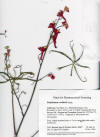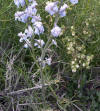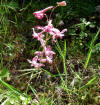|
Delphinium bicolor |
Delphinium cardinale
|
|
Delphinium glaucum
|
Delphinium parishii |
|
Delphinium purpusii |
Delphinium recurvatum |
|
Ahmad M., S. Yousuf, M. B. Khan, A. S. Ahmad, S. Saleem, M. N. Hoda and F. Islam. 2006. Protective effects of ethanolic extract of Delphinium denudatum in a rat model of Parkinson's disease. Hum. Exp. Toxicol. 25(7): 361368. Parkinson's disease (PD) is one of the major neurodegenerative disorders, and oxidative stress has been implicated in playing an important role in the pathogenesis of the disease. In the present study, we investigated if Delphinium denudatum extract can slow down the neuronal injury in 6-hydroxydopamine (6-OHDA) rat model of Parkinsonism. Rats were treated with 200, 400 and 600 mg/kg body weight (b.w.) of D. denudatum extract for 3 weeks. On day 22, 2 microL of 6-OHDA (10 microg in 0.1% ascorbic acid-saline) or vehicle was infused into the right striatum of the animals. Three weeks after the 6-OHDA injections, the rats were killed for estimation of lipid peroxidation (LPO), reduced glutathione (GSH) content, superoxide dismutase (SOD) and catalase (CAT) activities, catecholamines, dopaminergic D2 receptor binding and tyrosine hydroxylase (TH) expression. Increased LPO and significant depletion of reduced GSH content in the substantia nigra resulting from the lesion were appreciably prevented with Delphinium treatment. Delphinium extract also dose-dependently attenuated the activities of SOD and CAT in striatum, which had been reduced significantly by lesioning. A significant decrease in the level of dopamine (DA) and its metabolites and an increase in the number of dopaminergic D2 receptors in striatum were observed after 6-OHDA injection, both parameters were significantly recovered with treatment of the extract. Finally, all these results were confirmed by an increase in expression of TH in the ipsilateral striatum of the lesioned groups following treatment with Delphinium extract. Thus, the study indicates that D. denudatum extract may be helpful in checking neuronal injury in Parkinsonism. Inιs C. de, M. Reina, J. A. Gavνn and A. Gonzαlez-Coloma. 2006. In vitro cytotoxicity of norditerpenoid alkaloids. Z. Naturforsch. [C]. 61(1-2):1118. Forty-three norditerpenoid alkaloids isolated from Aconitum, Delphinium and Consolida species have been evaluated for their cytotoxic effects on the tumor cell lines CT26 (murine colon adenocarcinoma), SW480 (human colon adenocarcinoma), HeLa (human cervical adenocarcinoma), SkMel25 (human melanoma) and SkMel28 (human malignant melanoma) with several multidrug resistance mechanisms and the non-tumor cell line CHO (Chinese hamster ovary cells). Neoline (5), 8-O-methylcolumbianine (6), 1,14-diacetylcardiopetaline (9), 18-O-demethylpubescenine (13), 14-deacetylpubescenine (14), pubescenine (15), 14-deacetylajadine (25), lycoctonine (26), browniine (28), delphatine (29), dehydrotakaosamine (34), and ajadelphinine (37) exhibited selective cytotoxicity to cancerous versus non-cancerous cells. Some of these compounds had an irreversible effect on SW480 (5, 15, 25, 26, and 34), HeLa (15, 34, and 37) and SkMel25 (15 and 34) cell lines. In order to gain insights into the mechanism of irreversible cytotoxic action of these compounds we compared the cell viability by means of the 3-(4,5-dimethylthiazol-2-yl)-2,5-diphenyl-tetrazolium bromide (MTT) and the acid phosphatase (AP) methods. Our results suggest that the effects of these compounds could be related to the inhibition of ATP production. Pfister J. A., D. R. Gardner, N. L. Stegelmeier, K. Hackett and G. Secrist. 2003. Catastrophic cattle loss to low larkspur (Delphinium nuttallianum) in Idaho. Vet. Hum. Toxicol. 45(3):137139. Low larkspur (Delphinium nuttallianum) is a toxic plant found on many western US rangelands. Episodes of fatal poisoning are often related to the abundance and toxicity of the low larkspurs. This report documents the fatal intoxication of 53 cattle in a herd of 404 animals in south-central Idaho during Spring 2002. Low larkspur had a toxic alkaloid concentration of 8.26 mg/g. Several factors were involved in a loss of this magnitude, including climatic conditions ideal for low larkspur growth, poor grass growth during the spring, the high alkaloid concentration in larkspur, and the deaths of many cattle while being moved from the pasture. It is important for livestock owners and managers to recognize toxic plants growing in their area. If there is an unusual abundance of larkspur or other toxic plants, correct identification can provoke caution in grazing management. Puschner B., M. C. Booth, E. R. Tor and A. Odermatt. 2002. Diterpenoid alkaloid toxicosis in cattle in the Swiss Alps. Vet. Hum. Toxicol. 44(1): 810. Between 1995 and 1999, several cattle of a group of 80 heifers died acutely on a pasture in the Swiss Alps. The animals were found dead between July 9th and 15th each year. Only 1 animal was examined on post-mortem, and no significant lesions were found. Aconitum vulpera, A napellus, and Delphinium elatum were identified in the pasture. The presence of diterpenoid alkaloid-containing plants in the pasture, the rapid death of the animals, and the lack of pathologic lesions suggested diterpenoid alkaloid toxicosis as a cause of death. A multiresidue alkaloid screen using gas chromatography with a mass spectrometric detector was employed on rumen, abomasal, small intestine, and cecal contents from the I heifer. Deltaline, deltamine, and lycoctonine were identified. Aconitine was found in all gastrointestinal samples using a sensitive and highly specific liquid chromatography/mass spectrometry methodology for aconitine analysis. The findings of diterpenoid alkaloids in the gastrointestinal contents confirmed exposure to Delphinium and Aconitum spp, possibly resulting in sudden death. Ralphs M. H. and D. R. Gardner. 2003. Distribution of norditerpene alkaloids in tall larkspur plant parts through the growing season. J. Chem. Ecol. 29(9): 2013-2021. Previous research showed that toxic and total alkaloid pools in tall larkspur (Delphinium barbeyi) increased during early growth, then declined precipitously during the late flower and pod stage of growth. The objective of this study was to measure the concentration and pools of toxic and total alkaloids in tall larkspur plant parts, including roots, and to evaluate the changes in these pools over the growing season as an estimate of diterpenoid alkaloid kinetics in tall larkspur. Twenty entire plants were harvested at each phenological stage: beginning of growth in the spring, early flower, early pod, late pod, and senescence. The plants were separated into their respective parts, freeze-dried, extracted, and analyzed for toxic and total alkaloid concentration, and alkaloid pools were calculated. Concentration of toxic and total alkaloids in leaves and stems declined as the plants matured, while concentration in flowers and pods increased (P < 0.004). Concentration of alkaloids in the root declined in the early growth, then increased at the end of the season (P = 0.002). Alkaloid pools in the root decreased during early growth, with a corresponding increase of pools in foliar parts. In the late flower and pod stage, alkaloid pools in the leaves and stems declined rapidly, while the pool in the crown and roots tended to increase. Ralphs M. H., D. R. Gardner, D. L. Turner, J. A. Pfister and E. Thacker. 2002. Predicting toxicity of tall larkspur (Delphinium barbeyi): measurement of the variation in alkaloid concentration among plants and among years. J. Chem. Ecol. 28(11): 23272341. Tall larkspur (Delphinium barbeyi) is the principal mountain larkspur responsible for the majority of cattle deaths on mountain rangelands in western Colorado and central and southern Utah in the United States. Ten plants in each of two tall larkspur populations in the mountains near Ferron and Salina, Utah, were marked, and single stalks were harvested periodically through the growing season for 4 yr. Toxic alkaloid concentration [alkaloids containing the N-(methylsuccimimido)-anthranilik ester group] was determined by Fourier transform infrared (FTIR) spectroscopy. Individual larkspur plants varied in alkaloid concentrations, especially in early growth (14-38 mg/g). As the concentration declined over the growing season, variation among plants also declined. There were yearly differences in alkaloid concentration among individual plants (P < 0.01) and populations (P < 0.001), even after accounting for differences in phenological growth between years. Variables such as precipitation, temperature, days since snow melt, growing degree days (sum of mean temperature each day from snow melt), and plant height and weight were all considered in a Mallows Cp multiple regression selection procedure to predict alkaloid concentration. The mixed model procedure in SAS adjusted the regression equation for locations and years. Growing degree days was the best single predictor of alkaloid levels: In y = (3.581 - 0.00423 GDD), R2 = 0.85. Internal validation of this equation within individual years and locations from which the equation was developed, produced correlations between observed versus predicted values ranging from r = 0.73 to 0.93. External validations on nine other larkspur populations produced correlations ranging from r = 0.76 to 0.99. This predictive equation can provide a tool for ranchers and land managers to make management decisions of when to graze cattle in larkspur areas. Raza M., F. Shaheen, M. I. Choudhary, A. U. Rahman, S. Sombati, A. Suria, A. Rafiq and R. J. DeLorenzo. 2003. Anticonvulsant effect of FS-1 subfraction isolated from roots of Delphinim denudatum on hippocampal pyramidal neurons. Phytother. Res.17(1): 3843. The effects were investigated of a partially purified subfraction (FS-1) isolated from Delphinium denudatum on sustained repetitive firing (SRF) of cultured neonatal rat hippocampal pyramidal neurons. The blockade of sustained repetitive firing is one of the basic mechanisms of antiepileptic drugs at the cellular level. Using the whole cell current-clamp technique, sustained repetitive firing was elicited in pyramidal neurons under study by a depolarizing pulse of 500 ms duration, 0.3 Hz and 0.1-0.6 nA current strength. FS-1 (0.01-0.06 mg/mL) reduced the number of action potentials per pulse in a dose-dependent manner until no action potentials were elicited for the remainder of the pulse. There was a corresponding use-dependent reduction in amplitude and Vmax of action potentials. The Vmax of action potential 1 exhibited a dose-dependent reduction. At a dose of 0.06 mg/mL FS-1 reduced Vmax to 29%-38% and amplitude to 16%-20 % of the control values. The blockade of sustained repetitive firing by FS-1 was reversed by hyperpolarization of the membrane potential (-65 to -75 mV) while depolarization of the membrane potential (-53 mV to -48 mV) potentiated the block. The results suggest that FS-1 blocks sustained repetitive firing in hippocampal neurons in a use-dependent and voltage-dependent manner similar to the prototype anticonvulsant drug, phenytoin. However, unlike phenytoin, which binds preferably to the inactive state, the compounds present in FS-1 also interacted with the resting state of the Na+ channels by reducing Vmax of action potential 1. The results indicate that the partially purified FS-1 subfraction of Delphinium denudatum contains a potent anticonvulsant compound. Reina M., R. Mancha, A. Gonzalez-Coloma, M. Bailen, M. L. Rodriguez and R. A. Martinez-Diaz. 2007. Diterpenoid alkaloids from Delphinium gracile. Nat. Prod. Res. 21(12): 10481055. Two highly oxygenated hetisine-type diterpenoid alkaloids, delphigraciline (1), 14-hydroxyhetisinone N-oxide (2), and the norditerpenoid alkaloid 8-methoxykarakoline (3), were isolated from a neutral extract of Delphinium gracile. Their structures were elucidated on the basis of spectroscopic data and by comparison with previously reported spectroscopic data of similar alkaloids. Their antiparasitic and insecticidal activities are also discussed. Stegelmeier B. L., J. O. Hall, D. R. Gardner and K. E. Panter. 2003. The toxicity and kinetics of larkspur alkaloid, methyllycaconitine, in mice. J. Anim. Sci. 81(5):12371241. Larkspur poisoning sporadically kills from 5 to 15% of the cattle on North American mountain rangelands. Of the 40 different diterpenoid larkspur alkaloids, the one that is thought to be responsible for much of the toxicity has been identified as methyllycaconitine (MLA). Little is known of MLA toxicokinetics or excretion. The purpose of this study was to further characterize the clinical effects of MLA toxicity in mice and determine the toxicokinetics of MLA excretion. Eight groups of mice were dosed intravenously with 2.0 mg/kg of BW of MLA, killed, and necropsied at 0, 1, 2, 5,10,15, 30, and 60 min after injection. Treated animals were reluctant to move, trembled, and developed dyspnea, muscular twitches, and convulsions. Within several minutes, the clinical signs abated and behavior slowly returned to normal over approximately 20 min. At necropsy serum, brain, liver, kidney, and skeletal muscle were collected and frozen. Blood and tissues were extracted and analyzed for MLA with HPLC and electron spray mass spectrometry. Blood MLA elimination followed a normal biphasic redistribution and excretion pattern (r = 0.99) with a K of elimination of 0.0376 and half-life of 18.4 min. Other tissues had similar clearance rates. These data indicate the MLA is rapidly distributed and excreted. In mice, the clinical effects of poisoning seem to affect the central nervous system, causing dyspnea and "explosive" muscular twitches and convulsions. Because livestock commonly eat larkspur at subclinical doses, they are likely to have larkspur alkaloids in many tissues. These results suggest that animals exposed to larkspur should rapidly excrete MLA (within several hours) and that the residues in animal tissues are not likely to be a problem if animals are given several days to allow toxin clearance. Wada K., M. Hazawa, K. Takahashi, T. Mor, N. Kawahara and I. Kashiwakura. 2007. Inhibitory Effects of Diterpenoid Alkaloids on the Growth of A172 Human Malignant Cells. J. Nat. Prod. Nov The cytotoxicity against A172 human malignant glioma cells was examined for 14 alkaloids from the roots of Aconitum yesoense var. macroyesoense and of Aconitum japonicum and from the seeds of Delphinium elatum as well as for 25 semisynthetic derivatives. The major alkaloid constituents of A. yesoense var. macroyesoense, kobusine ( 2) and pseudokobusine ( 3), a minor alkaloid constituent of A. japonicum, aljesaconitine A ( 5), and six alkaloid derivatives, N-deethyldelcosine ( 10), N-deethyldelsoline ( 11), 12-benzoylluciculine ( 18), 12-anisoylluciculine ( 19), 6,11-dibenzoylpseudokobusine ( 28), and 6-veratroylpseudokobusine ( 29), had only very weak activity. Four acylated alkaloid derivatives, 12-acetylluciculine ( 23), 11-veratroylpseudokobusine ( 30), 11-( m-trifluoromethylbenzoyl)pseudokobusine ( 32), and 11-( m-trifluoromethylbenzoyl)kobusine ( 39), exhibited more potent activity, while pseudokobusine 11-cinnamoate ( 31), 11-anisoate ( 33), and 11- p-nitrobenzoate ( 34) were found to be the most potent cytotoxic agents. |
|







